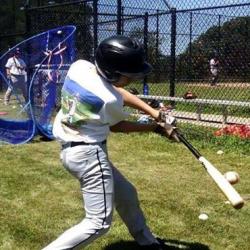The game has changed and in a very curious way, too. A proven recipe for success is being replaced by a penchant for the long ball.
A record 6,105 home runs were hit last year in Major League Baseball (MLB). But there’s a downside to baseball’s power game. It’s strikeouts. This past April, 6,656 strikeouts and 6,360 hits were recorded in MLB–the first month in history with more strikeouts than hits.
The day of the pure contact hitter, like Ichiro Suzuki, seems gone. Not only are strikeouts rising, but walks are the highest they’ve been in over 20 years (since 1996).
The ‘new MLB’ seems to have three outcomes–a home run, a walk, and a strikeout–and Joey Gallo is its poster child. During his career, Gallo has hit 70 HRs, has struck out 404 times, and has walked 141 times. The three outcomes account for nearly 70% of Gallo’s 900 MLB at-bats.
If strikeouts are connected to the urge to homer, what’s the root cause of the problem?
The simple solution is to blame pitchers. The famous saying, “Trust Your Fielders” seems more historical today than contemporary. That’s because strikeout pitchers are having the most success in today’s MLB. In 2017, 7 of the 10 pitchers who struck out the most batters (per nine innings) were also among the Top Ten in ERA.
But I don’t think you can hang the blame on pitchers. Here’s are three reasons why.
First, more and more MLB teams are drafting and calling up prospects who throw triple-digit heat. Teams value flamethrowers first and foremost, not control. Simply put, you can teach control, but you can’t teach velocity. And teams are siding with velocity. Consider that the average fastball was clocked at 88.6 mph in 2000. Last year the average increased to 93.1 mph.

The great Randy Johnson (photo, Grantland)
The result? Gone are the days when Randy Johnson was the only pitcher to blow away hitters with triple-digit fastballs.
Second, there’s advanced technology that enables coaches and pitchers to analyze hitting tendencies. Technology that tracks pitch velocity, movement, release point, spin, and pitch location enables analysis of when a hitter struggles, say with an inside cutter or a backdoor slider.
And that same technology can evaluate hitting aggressiveness. Jose Altuve, for example, led MLB last year with 279 first-pitch swings–successfully, too, with a .479 average. With that information, it’s easy for a pitcher to avoid delivering Altuve a hittable first pitch.
Data like these make it possible to put together a solid pitching game plan–hitter by hitter.
Finally, MLB is relying more and more on the bullpen. With more elbow and shoulder injuries, complete games are becoming a lost commodity. That approach not only keeps a starter’s arm fresh for the next start, it means hitters are facing the same pitcher less and less. Data speak to why. On average, a starting pitcher’s OPS rises from .705 to .731 to .771 in successive times through the lineup. But managers can pull the starter, replace him with a strategic replacement, and get a solid match-up.
But it would be a mistake to look only at pitchers and how pitchers are being used. Another reason is the risk-reward equation for hitters.
Hitters are less likely to be afraid to strike out (the risk) if it means they have a good chance of hitting a homer (the reward).
It’s reasonable to assert that the trend began in the late ’90s when Sammy Sosa and Mark McGuire captured national attention with their HR race. Since then, more and more hitters have eschewed an Ichiro-type approach (getting on base) in favor of elevated launch angles, which gives them a better chance of hitting a pitch out of the park. J.D. Martinez is a great example.
One way you can see today’s approach in action is how hitters approach a two-strike count. For decades, players with two strikes “choked up” on the bat to enhance bat control. The goal: put the ball in play, even if it means sacrificing power. But that’s happening less and less these days–and many managers and coaches are encouraging it, too. MLB hitting coach, Derek Shelton, put it this way: “Most coaches think that striking out is seemingly a forgivable sin these days if the player comes through now and then with a homer or a timely bases-clearing or game-winning hit.”

Courtesy: Pro Baseball Insider
But the approach to two-strike hitting isn’t the only symptom of the underlying problem. The larger issue is a change in philosophy regarding situational hitting.
For decades the preferred approach was simple–move the runner over. Today, though, hitters are more often than not swinging for the fences–and often striking out— with a runner in scoring position. What we seeing less of is a ground ball hit to advance a runner.
My favorite team, the Mets, are especially good (that is, bad) in that regard. A Mets’ announcer, Keith Hernandez, thinks the way to fix it is to give players a salary bonus if they consistently put the ball in play (rather than striking out) when runners are in scoring position.
But more than anything else what gets me is why teams and players prefer the long-ball approach. Last year’s two best teams–the Astros in the NL and Indians in the AL–had the lowest strikeout totals in the MLB. And, before those teams, there was the amazing Kansas City Royals.
When the Royals won big earlier this decade, their recipe for success was simple: put the ball in play. In both 2014 and 2015, the Royals were the only team in the MLB to strikeout under a thousand times AND those teams were also near the bottom of MLB in home run totals. The Royals won by following baseball’s ageless idiom: “Get on Base!”
But in today’s baseball, home runs are the thing. Strikeouts, too.
What do I think? Long live the single! The steal. The sacrifice. The game.
















